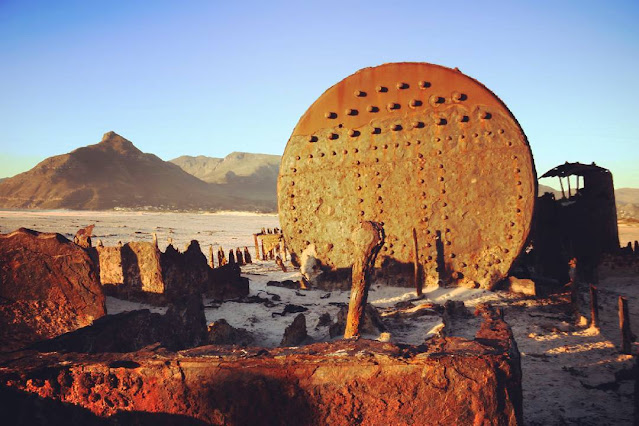South Africa: Western Cape shipwrecks: "SS Kakapo" | Кораблекрушения у побережья провинции Западный Кейп, ЮАР
665-тонный пароход SS Kakapo потерпел крушение у деревни Нордхук, Кейптаун, Южная Африка 25 мая 1900 на пути из Великобритании через Кейптаун в Австралию, в свой первый после спуска на воду рейс. Причина крушения: погодные условия. Попытки снять с мели и отбуксировать судно с пляжа не увенчались успехом. Жертв нет. Остатки корпуса видны до настоящего времени.
Facebook groups:
Photos: HiltonT
The historical SS Kakapo shipwreck is still visible closest to the Kommetjie side of Noordhoek Long Beach in Western Cape, South Africa.
 |
| SS Kakapo wreck in 2006 |
SS Kakapo (Kakapo is a type of New Zealand parrot) was a British steamer built in 1898 by the Grangemouth Dockyard Company and commanded by Captain P. Nicolayson. She was on her maiden voyage from Swansea in Wales, to Sydney in Australia.

Smoke rising from SS Kakapo funnel, 1900
The events leading to the SS Kakapo’s demise began to unfold as the steamship left Cape Town harbour in the afternoon of May 25, 1900. The 665 ton schooner rigged steamship was sailing with coal ballast for delivery to its new owners, the Union Steam Ship Company of New Zealand. This was Danish Captain Nicolayson’s first command, having received his captain’s ticket just months before.
His course would take the Kakapo south, following the west coast of the Cape Peninsula and then east around Cape Point and Cape Agulhas, the southernmost tip of Africa. In 1900, navigation depended heavily on charts, compass, sight of shore and lighthouses. The first light he would see would be the old Cape Point lighthouse, set high up on the Point and at times obscured by low cloud and fog.
An onshore North-Westerly gale was picking up as the vessel steamed south. SS Kakapo maintained her top speed of 9.5 knots, perhaps in haste to round the Point before sunset and ahead of the full onset of the storm. However the brunt of the storm soon bore down on the vessel, with huge seas, driving rain and near zero visibility.
At sunset, with poor visibility, it appears that the captain caught a glimpse of Chapman’s Peak, north of Noordhoek. Believing that he had just sighted Cape Point, he ordered the helm to steer hard to port, maintaining full steam. It wasn’t long however when the bridge caught sight of breaking waves directly ahead.
The full astern command would have little effect against the vessel’s forward momentum, the onshore gale and mountainous seas. The Kakapo run onto the sandy beach. The surge of heavy seas and tide would have shifted her even higher until the storm eventually subsided, leaving the Kakapo stranded.
Not a soul was lost in the stranding of the vessel. Two members of the crew of twenty climbed down to the beach in the dark and went in search for help. They spotted the lights of a dairy farm and were able to summon help. The next morning, all hands were able to climb down onto the sand, hardly wetting their feet.
A concerted attempt was made to refloat the ship, without success. She was firmly embedded in the sand. The Union Steam Ship Company lost its steamship before taking delivery and most of the steel of the superstructure and hull was eventually stripped for salvage.
It’s reported that the captain was so mortified by the loss of his ship that he stayed on board, refusing to leave and refusing to talk to the crowd of amazed locals, reporters and officials. Legend is that he lived on board for three years, before eventually being escorted off the vessel and taken to a mental facility.
Some 120 years later the remnants of Kakapo have been worn away by the sand, wind and waves. Only some fragments of her hull and boilers are visible in the sand now.
 |
| SS Kakapo wreck in 2002 |
Aerial photo/video service/inquiries: info@traveltonamibia.com









No comments:
Post a Comment